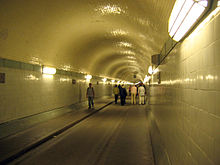- Elbe Tunnel (1911)
-
Old Elbe Tunnel or St. Pauli Elbe Tunnel (German: Alter Elbtunnel (coll.) or St. Pauli Elbtunnel (official name)) which opened in 1911, is a pedestrian and vehicle tunnel in Hamburg, Germany. The 426 m (1,398 ft) long tunnel was a technical sensation; 24 m (80 ft) beneath the surface, two tubes with 6 m (20 ft) diameter connect central Hamburg with the docks and shipyards on the south side of the river Elbe. This meant a big improvement for tens of thousands of workers in one of the busiest harbours in the world.
Four huge lifts on either side of the tunnel carried pedestrians, carriages and motor vehicles to the bottom. They are still in operation, though due to the limited capacity by today's standards, other bridges and tunnels have been built and taken over most of the traffic.
In 2008 approx 300.000 cars, 63.000 bicycles and 700.000 pedestrians used the tunnel. The tunnel is opened 24 hours for pedestrians and bicycles. For motorized vehicles opening times are currently Monday to Friday from 5.20 AM to 8.00 PM, on Saturdays from 5.20 AM to 4.00 PM.
Maintenance works are planned for 2009 and 2010 for the west bore and for 2010 and 2011 for the east bore.
Contents
History
On July 22, 1907 the construction of the tunnel started to connect the quarters of St. Pauli near the Landungsbrücken and Steinwerder.
Work was done under pressure because the tunnel was below the water table of the Elbe. This type of building technique was used in the 19th century, in large engineering excavations , such as with the piers of bridges and with tunnels, where caissons under pressure were used to keep water from flooding the excavations, such as the foundations of the Brooklyn Bridge in New York.
But workers who spend time in high-pressure atmospheric pressure conditions are at risk when they return to the lower pressure outside the caisson without slowly reducing the surrounding pressure. Due to the problems associated with decompression sickness, many of the men working on the Elbe tunnel were affected by, what was known at the time, Caisson's Disease. Three men died, 74 suffered severe cases and more than 600 came down with light symptoms among 4,400 workers.
The tunnel opened on September 7, 1911.
Modern usage
In the tunnel an art exhibition (ElbArt (German)) and a long-distance running event Elbtunnel-Marathon (website of the organiser (German)) are taking place.[1] In 2008 the tunnel participated in the Tag des offenen Denkmals (Day of the open heritage site), a Germany-wide annual event sponsored by the Deutsche Stiftung Denkmalschutz, that opens cultural heritage sites to the public.[2]
Media
The old tunnel has featured in several films including The Odessa File, $ (film), and The American Friend (Der Amerikanische Freund).
Decoration
The tunnel walls are decorated with glazed terra cotta ornaments displaying items related to the Elbe river. While mostly fish or crabs, a few show different items like waste and rats, too.
See also
- (New) Elbe Tunnel
References
- ^ Newspaper article on the marathon 2007 Runter in die Röhre (Down into the tube) Hamburger Abendblatt (German) Retrieved on July 31, 2008
- ^ "Tag des offenen Denkmals 2008" (in German). Behörde für Kultur, Sport und Medien (Ministry of Culture, Sports and Media). June 2008. http://www.hamburg.de/contentblob/380836/data/tag-des-offenen-denkmals-2008.pdf. Retrieved 2009-08-29.
External links
Coordinates: 53°32′44.46″N 9°58′11.73″E / 53.5456833°N 9.969925°E
Categories:- Buildings and structures in Hamburg
- Heritage sites in Hamburg
- Transport in Hamburg
- Tunnels in Germany
- Visitor attractions in Hamburg
- Tunnels completed in 1911
Wikimedia Foundation. 2010.







